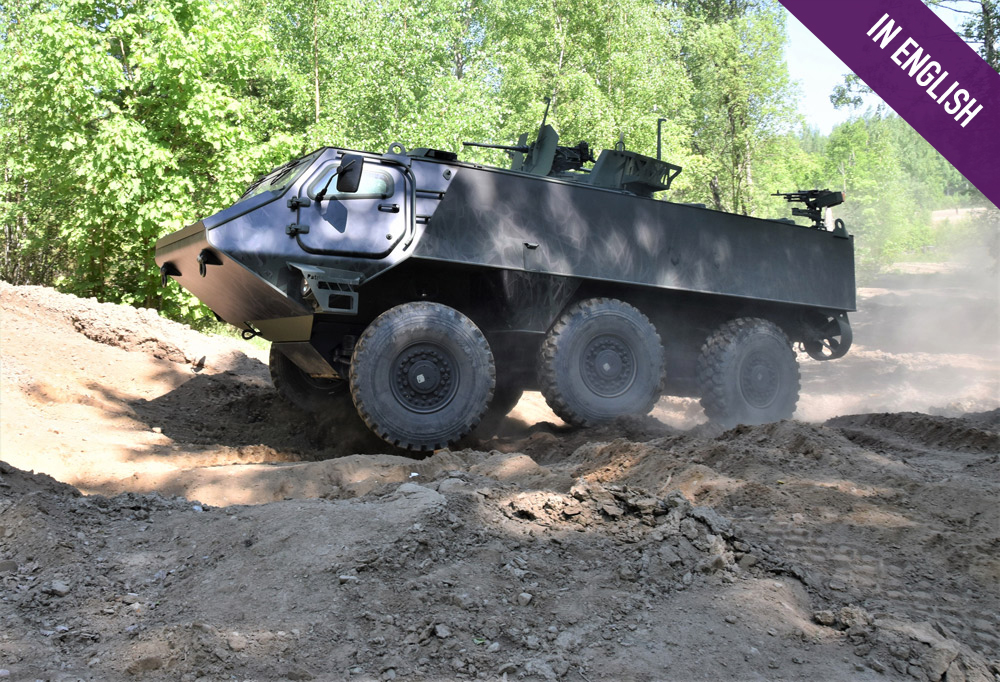Estonia joined the cooperation programme for sustained army mobility enhancement
This article was published in Ruotuväki on April 17th 2020 in Finnish. The development programme for sustained army mobility enhancement is now beginning in cooperation with Latvia and Estonia. Conducting international cooperation results in cost-effective solutions.
In cooperation with Latvia and Estonia, the Finnish Army implements a development programme for sustained army mobility enhancement. In January this year, Latvia joined the development programme, and, in early April, the Ministry of Defence released information on Estonia’s joining the programme.
As part of this programme, the Finnish Army’s objective is to generate and secure wheeled mobility of the most-capable operational forces of the Army capable of operating across the nation well into the 2040s.
– This programme tangibly aims to develop a cost-effective new armoured wheeled vehicle system that complies with the set Army capability requirements and, on a separate decision, to procure the given system if the new vehicle system meets the set capability requirements, Inspector of Infantry, Colonel Rainer Peltoniemi summarises.
Internationally, this programme and cooperation stimulate interest. According to Colonel Peltoniemi, the trilateral cooperation treaty allows also other nations to join to utilise the benefits.
– Each nation follows its own set development timetable. As vehicle fleets tend to be replaced every 20–30 years, it is obvious that those nations for whom this is topical are also bound to be interested in this programme, Colonel Peltoniemi says.
The benefits of multinational cooperation accrued in this programme include cost-efficiency in particular. When a number of nations are part of the development programme, they also share the costs together.
– Conducting multinational cooperation increases the programme volume and enables substantial cost-efficiency. It pays off to keep in mind that the life cycle of this type of a vehicle system is approximately 30 years. Apart from the procurement acquisition costs, this means accounting for the overall life cycle costs, maintenance, servicing and spare parts as well as possible system modernisation. Multinational cooperation opens up versatile options for getting things done cost-effectively, Colonel Peltoniemi points out.
Based on national and multinational tests and evaluations, the vehicle chassis platform chosen for the basis of the development in-progress is a Finnish-made Patria 6x6 armoured wheeled vehicle chassis platform. The vehicles are necessary in tasks of national defence and crisis management. According to Colonel Peltoniemi, utilisation of streamlined equipment in international duties brings down the costs of logistics and increases combined connectivity.
– The three nations have defined combined capability requirements for the new armoured vehicle system. It is clear that a combined vehicle system generates additional opportunities also for conducting training cooperation and exercising. In light of security of supply and life cycle costs, it is excellent that Finland and our neigbours now bring about a more extensive vehicle cluster to meet the set needs better under exceptional circumstances as well. Led by Patria, the companies partaking in this programme generate multinational industrial cooperation that in turn improves the participating nations’ security of supply and their cooperating template also for preparing for exceptional circumstances, Colonel Peltoniemi explains.
Usually multinational cooperation programmes tend come into being for the purpose of achieving cost-reductions and establishing system connectivity. Colonel Peltoniemi says that it may often be the case that a number of countries feature varying capability requirements that then turn out to be somewhat incompatible. Therefore, it is not always possible to implement cooperation programmes without agreeing on significant additional costs or compromising.
– Additionally, each nation has its own armed forces’ development programme, timetable and resources. In case these end up being significantly different, it is difficult to agree on a combined cooperation timetable and defence industry production capacity. These factors may then impede the implementation of combined programmes, Colonel Peltoniemi describes.
According to Colonel Peltoniemi, the next programme phase involves product development. This is, a product development agreement will enable the participating nations to order specifically defined product development to generate vehicle versions and allow for serial procurement acquisitions. Product development will also include entities that focus on developing combined servicing, logistics and training solutions. After this, a framework contract is to follow that will then enable the nations to implement on separate decisions the serial procurement acquisitions concerning the developed vehicle versions.
– Each nation implements on its own decision its national procurement acquisitions. The objective is to finalise the combined product development agreement by this summer which would allow for basic vehicle pre-production to start this year to be followed by version production in 2021. National procurement acquisitions could then begin in 2021 as well, Colonel Peltoniemi explains.
Armoured wheeled vehicle systems remain relevant in contemporary national defence. According to Colonel Peltoniemi, rapid operational mobility as required by long distances and excellent tactical terrain mobility are key in army combat.
– Armoured vehicle systems provide both cover from adversary weapon system impact and capability for massing and concentrating own force quickly and surprisingly to the decisive point of battle. Agile mobility is decisive in army operational capability, Colonel Peltoniemi emphasises.



